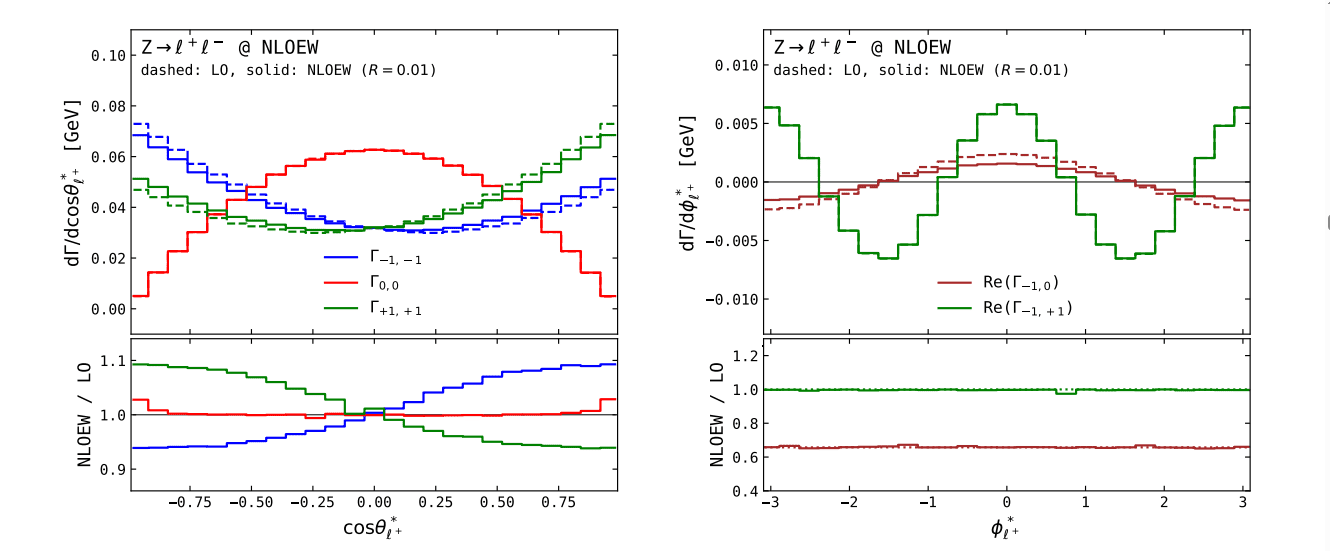Understanding the fundamental properties of particles requires precise measurements, and a team led by Morgan Del Gratta from the University of Milano, Federica Fabbri and Michele Grossi from CERN, are refining techniques to achieve this with greater accuracy. They investigate how subtle quantum effects influence the decay of Z bosons, particles that mediate the weak nuclear force, and find unexpectedly large corrections to measurements of particle spin. This research demonstrates that these corrections stem primarily from shifts in a key parameter related to spin analysis, and crucially, that standard methods for accounting for radiation can significantly distort results. To overcome these challenges, the team develops a novel quantum tomography procedure, applicable to various particle decays, that promises more robust and reliable measurements of fundamental particle properties, and represents a significant step forward in precision particle physics.
One-Loop Electroweak Corrections to Z-Boson Decays
Scientists have investigated electroweak radiative effects in Z-boson decays, addressing a long-standing challenge in precision electroweak measurements. The team performed a detailed analysis of one-loop electroweak corrections, including both initial and final state radiation, to improve the accuracy of theoretical predictions. Calculations demonstrate a significant enhancement of these effects compared to previous approximations, particularly for observables sensitive to the transverse polarization of the Z boson, providing a crucial step towards resolving discrepancies between theory and experiment.
Precise Diboson Rates via Electroweak Corrections
Z-Boson Spin Structure and Radiative Corrections
Scientists have achieved a precise understanding of electroweak radiative effects in Z-boson decays, crucial for accurately determining particle spin configurations at colliders. The research team investigated the Z-boson spin-density matrix to next-to-leading order, revealing significant shifts in the spin-analysing power parameter, which alone accounts for unexpectedly large corrections observed in experimental data. Further analysis focused on boosted Z bosons, where radiation treatment significantly impacts spin-density matrix coefficient extraction. To address these challenges, the team developed a quantum tomography procedure applicable to final states containing one or more on-shell Z bosons, demonstrating its robustness against higher-order corrections. This procedure allows for reliable reconstruction of the overall spin-density state, enabling direct comparison with theoretical predictions. The study extended to Higgs boson decay into two Z bosons, confirming the importance of considering higher-order corrections to both decays, delivering a sound prescription for extracting the coefficients of the ZZ spin density matrix and advancing our understanding of particle spin configurations at high energies.
Z-Boson Spin Density Matrix Radiative Corrections
This research presents a detailed investigation into electroweak radiative corrections affecting quantum tomography, a procedure used to reconstruct the spin states of particles produced at colliders. The team calculated the Z-boson decay spin-density matrix to next-to-leading order and found significant shifts in the spin-analysing power parameter, which alone accounts for unexpectedly large corrections observed in experimental data. Furthermore, the study demonstrates that the treatment of radiation within lepton-dressing algorithms impacts the accuracy of spin-density-matrix coefficient extraction at next-to-leading order. To address these challenges, the researchers propose a robust quantum tomography procedure applicable to final states containing one or more on-shell Z bosons, designed to minimise the influence of higher-order corrections. They validated this procedure using both Z-boson pair production and Higgs-boson decay scenarios, suggesting that continued development of this technique will be crucial for accurately determining the spin states of particles at colliders and advancing our understanding of fundamental particle interactions.
